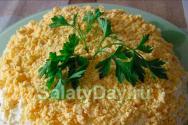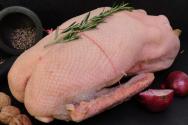Video recipe: Georgian chicken satsivi (classic recipe). Satsivi - nut sauce What is satsivi and how to prepare it
Dear readers, today we’ll talk to you about the traditional Georgian dish satsivi. Translated from Georgian, this dish is called cold. In this country Not a single holiday goes by without this dish. and it is always prepared for future use. By satsivi we mean a sauce made from walnuts and spices, and you can add it to absolutely any meat. Classic ingredients for this dish are nuts and poultry. Often this is turkey or chicken. Let's look today at how to cook Georgian chicken satsivi using classic recipe.
Satsivi recipe with chicken and nuts
Kitchen appliances and utensils: hob, saucepan, knife, cutting board.
- You can boil the chicken in advance. If desired, this can be done even the day before preparing satsivi. To do this, you need to wash half the carcass, add water, add an onion, pepper, salt, 2 bay leaves and place on the stove. At the end of cooking, about 40 minutes after simmering over low heat, add parsley and dill roots. Use cooled chicken to prepare food.
- Satsivi sauce should be rich, with a pronounced nutty taste, so you don’t need to add a lot of fresh herbs to it. I recommend passing nuts through a meat grinder 2 times until separated nut butter, this way we will get the ideal consistency of our sauce.
- Wine vinegar can be substituted freshly squeezed pomegranate or lemon juice.
- As the sauce cools, it will become thicker, so Adjust the amount of broth yourself. As a last resort, you can dilute the already prepared sauce with it.
Step by step recipe
- Wash and remove excess from one bunch of green cilantro. A small bunch is enough so as not to overwhelm the taste of the other ingredients with herbs. Peel the garlic, about 6 cloves, and wash. The amount of garlic can be as large or small as you wish.

- Grind cilantro, garlic and 200 g of nuts in a meat grinder. The nuts can be crushed in a mortar, then we can get a more grainy sauce. Place the resulting mixture in a saucepan.

- Peel three onions, wash them and grate them on a fine grater. Fry onion puree in a frying pan with vegetable oil. If there are large pieces in the onion, they should be removed.

- We need to simmer the onion a little, but not fry it, so during the cooking process you can add chicken broth to it. You need to cook it for about 10 minutes and then add it to the nut mixture.

- Add 2 tsp there. saffron, 3 tsp. hops-suneli, 0.5 tsp. red pepper and freshly ground coriander seeds.

- Add 1 liter of broth to the nut mass. Put the mixture on the fire and simmer, stirring occasionally. When cold it will be like thick sour cream.

- When the sauce is hot, you will need to taste the spices and add them to your taste. If desired, use more seasonings to prepare satsivi.

- Be sure to add salt, about a couple of pinches of salt. Be sure to stir the sauce during cooking and not let it burn.

- Pour 3 tbsp into the mixture. l. vinegar. Don't be afraid to add more than you need because the meat will take it up later.

- When the sauce starts to boil, turn it off and remove from the heat. In Georgia it is eaten cold.

- Divide the boiled chicken into portions. The skin and excess bones can be removed. Place the meat in a serving plate and pour over the nut sauce. Some families simply divide the chicken, leaving the meat on the bone and not removing the skin. Do as you please.

Video recipe
Dear readers, I invite you to watch a short video in which you will learn all the details of preparing Georgian satsivi with walnuts and chicken. You will see how to properly prepare the ingredients, learn some recommendations for preparing it, and understand what the sauce will be like when fully prepared.
Thanks to open borders between countries, recipes for various national dishes travel around the world and find their fans. So is the Georgian satsivi, which is national dish of this country is gaining popularity in our area. The first time I had to try it was at a friendly meeting, when a friend decided to surprise us with her culinary skills. She really succeeded because her satsivi was truly Georgian, the spices were well felt in it. Let's look at another simple recipe for satsivi from domestic chicken, which even an inexperienced housewife can easily handle.
Satsivi from homemade chicken
Cooking time: 35 minutes.
Number of servings: for 8 people.
Calories: 251 kcal per 100 g of product.
Kitchen appliances and utensils: meat grinder, hob, thick-bottomed saucepan, frying pan.
Ingredients
Step by step recipe
- Wash the homemade chicken thoroughly, add water, add 5 peeled cloves of garlic, peeled onion and a sprig of cilantro, 5 peppercorns. After boiling, cook the chicken over low heat for 1 to 2 hours, depending on the age of the bird.

- Grind 600 g of nuts using a meat grinder. Repeat this process 2 times. If you want the nut pieces to be noticeable in the sauce, then 1 time is enough.

- Finely chop 3 onions and fry until translucent. Then grind it in a meat grinder and send it to the nuts.

- Place the nut mass in a saucepan on the fire. Gradually add a liter of broth to it. After boiling, you need to reduce the heat and simmer the sauce for 10 minutes, stirring.

- You can add more broth during the process if the sauce becomes too thick. You can adjust its consistency at your discretion.

- Pour 1 tsp into the sauce. salt, cilantro and utskho-suneli, 0.5 tsp each. red pepper, saffron and cinnamon. You can adjust the amount of seasonings yourself to get the taste that suits you best. And at the end of cooking, pour 2 tbsp. l. vinegar.

- Cut the chicken into portions, removing the bones. Place in a serving plate and top with nut sauce. Store the sauce and chicken separately in the refrigerator.

Video recipe
And this short video shows in more detail the entire process of preparing the above recipe. You will see how the finished sauce turns out.
Serving options
- The food can be served in portions, placing poultry meat on the bottom of a deep plate and pouring sauce on top. You can decorate with a sprig of cilantro, dill or parsley.
- In Georgia, this dish is served on festive table , so we can also adhere to these traditions.
- This the dish is high in calories and filling, so don’t get too carried away with it if you care about your figure.
Cooking options
- Today we learned how ordinary chicken can be served with nut sauce and get the famous Georgian dish. I also want to leave you several cooking options delicious meat birds, which you will surely like.
- One more traditional dish Georgian is, which is cooked in a frying pan under pressure. In this country, such a device is called “tapa”, so the food was called “tapaka chicken”, and we changed it to “tabaka”, which is more convenient for us. It’s very easy to prepare it, even without a special frying pan, so try it, it’s not for nothing that such a dish was very popular in our area in Soviet times.

- You can also do it. For me, this is a more acceptable option for preparing it, because it is very simple, and the chicken turns out juicy and even healthy. Take the recipe for this dish into your piggy bank and enjoy very tasty chicken.
- Now it is gaining its popularity in our country. This dish is very popular in children's and dietary nutrition. But it is also perfect for diversifying your everyday menu, when you want something unusual and delicate.
- Here is a variant of cooking meat that is very popular among my friends: it is prepared very quickly and simply, so we often make it for a snack during the working day, or take it with us on nature trips and picnics. My children love this dish very much, so I cook it quite often. I recommend that you use this simple recipe for a delicious meat dish.
Dear chefs, I hope I was able to be useful to you today and juicy Georgian chicken with nut sauce is already ready in your kitchen. Write in the comments if you liked the dish. If you have any questions or suggestions, leave them in the comments, I will definitely take a look at them. Perhaps you have recipes that are very simple dishes, which you often cook, leave them too, I will be happy to use your recommendations. And now I wish you success in cooking and bon appetit!
Not every housewife knows how to cook satsivi. All you need to do is buy more nuts and choose a recipe to suit your taste. You can use not only meat, but also fish, mushrooms and even eggplants.
There is not just one recipe for satsivi, there are many of them. Their homeland is Georgia, where this term is usually used to denote the name of the sauce. But not everything is so simple, and in fact, a whole section of cooking is hidden behind the beautiful word.

In national Georgian cuisine, it is customary to serve a special sauce with meat, poultry and fish, which is called “satsivi”. But for simplicity, this is what the whole dish is called. That is why there is no single recipe that would correspond to this name.
The menu of any Georgian restaurant will certainly have several variations of satsivi, each of which is a real celebration of taste and aroma!
Most often, the sauce is served with chicken or turkey. This combination is considered classic. However, in modern kitchen There are recipes without meat component. Delicious sauce goes well with fish, meat, as well as dietary vegetarian dishes.
Principles and rules of cooking
The main and constant component of satsivi is walnuts. They are shelled and chopped. The goal is to get pieces that are roughly equal in size, but with only a small amount of nut flour.
In addition to the sauce, prepare:
- cinnamon;
- Imeretian saffron (you can use regular saffron);
- garlic;
- black pepper;
- khmeli-suneli;
- wine vinegar or lemon or pomegranate juice.
To add thickness, use flour or egg yolks. A must-have green is cilantro, and you can add other herbs to suit your taste. Satsivi sauce is prepared differently in every home, varying the components according to the particular dish it will be served with.
How to cook satsivi - the most delicious recipes

Depending on what exactly satsivi will be served with, the composition and proportions of its components change, as well as the cooking technology itself. The 7 recipes offered are the classic satsivi recipe itself, as well as the most popular and delicious interpretations. The first one should be served to guests for a festive feast, and the other should be pampered with loved ones on the weekend.
Classic recipe with chicken
Ingredients:
- 1 carcass of chicken or turkey;
- 2 onions;
- 400-500 g walnuts;
- 4 cloves of garlic;
- 2 bay leaves;
- 1.5 tsp. utskho-suneli (fenugreek);
- 1.5 tsp. coriander;
- 2.5 tsp salt;
- 1 tbsp. flour;
- 1 tsp red hot pepper;
- on the tip of the knife - saffron;
- 0.5 tsp nutmeg;
- 3 tbsp. wine vinegar or pomegranate juice;
- 2 tbsp. sesame oil.
Boil the bird carcass with 1 onion (entirely) and a bay leaf to produce a rich but light broth. The bird is removed and the broth is filtered. The carcass is cut, selecting meat, removing bones and skin.
The second onion is stewed, chopped, in sesame oil until golden brown. It is important that it does not become dry. The nuts and garlic are chopped or passed through a meat grinder. Mix in all the other spices and flour. You can add salt, but not necessarily. You can refuse red pepper if you don’t want to get spicy sauce. Pour 2 cups warm chicken broth and knead thoroughly.
Nut mixture Place on the onion and bring to a boil, stirring continuously. Simmer, gradually adding another glass of broth. The finished sauce should have a consistency similar to sour cream. At the very end, add prepared vinegar, or you can use fresh or canned vinegar instead. pomegranate juice.
The meat is poured over the entire volume of sauce at once and placed in the refrigerator for at least 4 hours. You can immediately put it on plates. Already on the table, sprinkle with fresh chopped herbs and sprinkle with sesame oil.
Chicken in bage
Ingredients:
- 2 chicken carcasses;
- 500 g walnuts;
- 7 cloves of garlic;
- 3 tsp spicy adjika;
- 2 people ground coriander with utskho-suneli;
- 1 tsp Imeretian saffron;
- salt to taste.
The bird is cut into convenient portions, lightly fried in a frying pan, and finished in the oven until done (20 minutes at 200 °C). The nuts are finely ground in a meat grinder along with garlic and adjika. The resulting mixture must be squeezed out. The squeezed out oil is removed separately.
The squeezed mass is diluted with 100 ml of boiling water, kneaded and a little more boiling water is added (a total of 500-600 ml) until you get a sauce with a thickness reminiscent of kefir. Now mix in all the other seasonings to get a homogeneous mass.
When the chicken is ready at this point, pour the sauce over it so that all the pieces are covered evenly. Wait until the meat has cooled completely, and only then put it in the refrigerator. After 4 hours, take it out, pour over the previously squeezed oil and serve it cold.
It is not worth preparing for future use; the finished dish can be stored for a maximum of 2 days in the refrigerator.

Ingredients:
- 200 g walnuts;
- 600 g eggplants;
- 1 onion;
- 2 cloves of garlic;
- 1 bunch of cilantro;
- 1 tsp wine vinegar;
- 1 tsp utskho-suneli;
- 0.4 tsp red hot pepper;
- 0.5 tsp salt;
- 0.5 tsp Imeretian saffron;
- 1 tbsp. sesame oil.
Remove the skin from the eggplants and cut them into 1 cm thick slices. Add some salt and leave for 1 hour. Then squeeze out the juice. This removes the bitterness from them. Fry the vegetables in a small amount of oil, and then drain the juice along with the oil.
The nuts need to be ground together with onions, garlic and cilantro. Add vinegar, spices and salt. Stir the sauce. If it is too dry and thick, add a little boiling water. Rolls are made from fried eggplants and the sauce is placed inside. Place in the refrigerator for a couple of hours and serve sprinkled with pomegranate seeds.
From fish
Ingredients:
- 500 g trout;
- 100 g walnuts;
- 1 onion;
- 3 cloves of garlic;
- 300 ml fish broth;
- 3 tbsp. wine vinegar;
- 0.5 pods of red hot pepper;
- greens - parsley, cilantro, dill.
- 1/6 tsp each cinnamon, cloves, black pepper.
- salt to taste.
Boil the fish (20 minutes maximum). The fillet is taken out and cut into several pieces. There should be no bones or skin. The broth is filtered and set aside. Grind the nuts with spices and pour in a glass of fish broth, stir. Boil the remaining broth with finely chopped onion and garlic.
Add the nut mixture and boil everything together for 10 minutes. Pour the sauce over the fish, sprinkle with herbs, and you can immediately serve it on the table, offering it as a side dish. Rye bread or pita bread.

Ingredients:
- 1.5 kg turkey drumsticks;
- 2 onions;
- 200 g walnuts;
- 2 cloves of garlic;
- 0.5 tsp dried cilantro;
- 0.5 tsp utskho-suneli;
- 1 tsp Imeretian saffron;
- 1/6 tsp ground cinnamon;
- 2 tsp wine vinegar;
- 2 tsp wheat flour;
- salt to taste;
- 1 tsp hot adjika without tomato;
- 2 bay leaves;
- 6 black peppercorns.
The turkey is boiled with black peppercorns, bay leaves and 1 onion. Cook for about 40 minutes. The foam is removed so that the decoction remains light in a volume of about 1 liter. The meat is removed and placed in the oven to bake at 200 °C for about 20 minutes. for golden brown crust.
Finely chop 1 onion and brown in a small amount of oil in a frying pan. Grind nuts with garlic and adjika in a meat grinder twice. Squeeze the oil out of this mixture and set it aside. Dilute the nuts with broth, add the remaining spices and vinegar at this point. You need to achieve medium thickness by adding broth. 5 minutes. Boil the sauce to thicken.
Place the meat, cut into pieces (without bones), directly into the pan with the sauce, mix and put in the refrigerator for 4 hours. When serving, pour over squeezed oil and sprinkle with finely chopped herbs.

Ingredients:
- 200 g nuts;
- 2 onions;
- 3 sprigs of cilantro;
- 0.5 tsp each ground cloves and cinnamon;
- 800 ml water;
- 6 eggs;
- 1 tsp vinegar;
- 2 cloves of garlic;
- 0.3 tsp black pepper;
- salt to taste.
Grind nuts with garlic, herbs and salt. Squeeze the oil out of the resulting mass and set aside. Add pepper and cinnamon to the nuts, sprinkle with vinegar and knead thoroughly. Dilute the resulting mixture with boiling water, place in a saucepan with the fried onions and boil everything together for 10 minutes. Over the boiling sauce, carefully break the eggs one by one and lower them whole into the hot mixture.
After 7-8 minutes, turn off the stove and let the dish cool. Serve on the table in plates, pouring the oil that was squeezed from the nuts on top.
From mushrooms
Ingredients:
- 300 g champignons;
- 100 g walnuts;
- 1 onion;
- 4 cloves of garlic;
- 1 bunch of cilantro, dill and parsley;
- 200 ml broth;
- salt to taste;
- 1/3 tsp. black pepper;
- 1/3 tsp. utskho-suneli;
- pomegranate seeds for decoration;
- 1 tbsp. sesame oil.
Mushrooms are cut in half or quarters and boiled in clean water until soft. The broth is decanted to be used later. Fry finely chopped onion in sesame oil until golden brown. Nuts, herbs and garlic are placed in a blender to grind everything together. The nut mixture is mixed with mushrooms, and broth is added to make the sauce thicker. Add all remaining seasonings.
Once the dish has cooled completely, place it on plates, sprinkled with pomegranate seeds for beauty.
To make the cooking process easier, you can use the tips.
- Instead of a bird carcass, you can use fillet, the result will be no worse. In addition, the sauce is perfect for all types of meat: beef, pork, lamb. Freshly cooked (boiled or baked) meat is covered with satsivi and put in the refrigerator to brew.
- You shouldn’t give up traditional spices, but you should take into account that main taste The sauce contains only three ingredients: utskho-suneli, saffron and cilantro. You can safely take the rest of the seasonings to your liking.
- You can use a blender to grind the nuts, but strive to ensure that the resulting mass remains crumbly and does not turn into flour.
- The dish should only be stored in glass containers, as its taste may change in any other container.
In most recipes for nut mass with spices, after grinding through a meat grinder, it is recommended to squeeze out the oil. The purpose of this operation is to give the sauce the desired thickness and consistency.
If the oil is not squeezed out, then satsivi will still be tasty, but very different from its original.
Conclusion
Satsivi is exactly the sauce that almost everyone likes. You can safely include it in your holiday menu, without fear that the guests will not like it. Over time, the cooking process will become familiar, and the dish will surely become your favorite!
Unique Georgian satsivi. No one who has tried this miracle has ever remained indifferent. However, not everyone knows: in fact, this term was originally the name of the sauce, which later became the name of the snack. Traditional recipes satsivi - with chicken meat. But there are also original variations, for example with the noblest fish, sturgeon. It is not forbidden to use goose, duck, turkey, veal and even pork. The sauce itself leaves no less room for imagination. If walnuts and cilantro are mandatory components, then each cook composes a set of spices based on his own experience and preferences. It may include cinnamon, Imeretian saffron, suneli hops, coriander, pepper, onion, garlic and other seasonings.
The five most commonly used ingredients in recipes are:
In addition to nuts, the ingredients often contain egg yolks and flour as thickeners. There are subtleties and nuances in the preparation of each dish. IN in this case, this is chopping nuts. Meat grinders, blenders and food processors that are convenient for housewives are not good helpers here. Ideally, grind the kernels in a mortar. It is possible to prepare dozens of satsivi different ways. Each kitchen has individual secrets and sacraments. The dish is usually served cold, but there are also those who like to try the Caucasian delicacy “hot from the heat.”
Satsivi is a national Georgian dish. He is known and loved all over the world. The name means “cold”, so the dish is served chilled in a nut sauce. Traditionally, satsivi is made from chicken. Sometimes turkey meat is used or stuffed nut butter eggplants. Even fish is prepared this way.
In Georgian cuisine, attention is paid to herbs and spices. Flavored sauces prepared with the addition of fresh herbs - mainly cilantro, basil and dill.
In the Caucasus they say: “The Georgian table is like a Georgian song...”, and what song, and even a festive one, would be without the most tender satsivi! Try to cook a dish according to one of the recipes, and your culinary talent will be appreciated.
Satsivi is prepared from domestic chicken weighing about 2 kg. The meat of such a bird is juicy and soft. Nut kernels are used in the following proportion: per 1 kg of chicken – 500 g. nut kernels.
Serve satsivi cold, garnish with lemon slices and herbs.
Ingredients:
- chicken – 1 piece;
- onion – 1 piece;
- bay leaf – 2 pcs;
- black peppercorns – 10 pcs;
- parsley root – 1-2 pcs.
For the sauce:
- green cilantro – 1 bunch;
- garlic – 8 cloves;
- walnut kernels – 400-500 g;
- onions – 3 pcs;
- Imeretian saffron – 3 tsp;
- hops-suneli – 4 tsp;
- ground red pepper – 1 tsp;
- ground coriander – 1 tsp;
- vinegar, or wine vinegar – 5 tbsp;
- sunflower oil -100 ml;
- salt – 1 tbsp. or to taste.
Preparation:
- Rinse the chicken, cover with water and bring to a boil. Add peppercorns, bay leaves, onions cut in half to the boiling broth, and after 30 minutes add peeled parsley root. Cook for about an hour.
- Prepare peanut sauce. Finely chop the onion and simmer sunflower oil until transparent, pour in 2-3 ladles of broth and simmer over low heat for 10 minutes.
- Sort the walnut kernels from the partitions, grind them in a blender or in a mortar along with cilantro and garlic.
- Add nut paste, spices, 600 ml of broth to the stewed onion, add salt to taste and simmer over medium heat for 15 minutes, stirring constantly. Add broth as needed to ensure the sauce is creamy and does not burn.
- Season the nut sauce with wine vinegar, bring to a boil, remove from heat, and cool.
- Cut the finished chicken into portions, remove the skin and large bones.
- Place the cooked meat in a tureen or stewpan, pour over the sauce and refrigerate for 10 hours.
In the Caucasus, cold poultry appetizers are prepared not only on holidays, but also on weekdays. The finished dish is placed in a cool place overnight and served only the next day along with lavash or mchadi flatbreads; satsivi is stored for no more than 2 days.
Serve the dish chilled on portioned plates, garnish with basil and cilantro leaves on top. Pickled eggplants and cream cheese go well with satsivi.
Ingredients:
- chicken - half a carcass;
- onion – 1 piece;
- allspice peas – 5-7 pcs;
- bay leaf – 1 pc.
- salt – 1 tsp;
- vegetable oil – 75 ml;
Sauce:
- walnut kernels – 1 cup;
- onions – 3 pcs;
- ghee – 2-3 tbsp;
- utskho-suneli – 1 tsp;
- coriander – 1 tsp;
- ground chili pepper – 1 tsp;
- saffron – 1 tsp;
- cilantro, parsley, basil - 1 bunch;
- garlic – 3 cloves;
- vinegar – 1-2 tbsp;
- salt - to taste.
Preparation:
- Boil the washed chicken until half cooked for 30-40 minutes. After boiling, add the onion, bay leaf, allspice and salt to the water.
- For the sauce onion Peel and grate on a fine grater or grind in a blender. Simmer the onion pulp in melted butter, finally pour in 1 cup of broth and bring to a boil.
- Mince the walnut kernels along with the herbs and simmer with the onion, stirring constantly for 5 minutes.
- Finely chop the garlic, add to the sauce, sprinkle with spices, pour in vinegar, salt to taste and simmer over low heat for 10 minutes.
- Heat in a frying pan vegetable oil, divide the boiled half carcass into portions and fry until golden brown.
- Place the chicken pieces in a saucepan with nut sauce, stir gently, let it boil and remove from the stove. Keep the satsivi in the refrigerator for 10-12 hours.
Satsivi from chicken legs in a slow cooker
To prepare this recipe, you can use chicken or turkey wings and poultry fillets. Turkey meat takes a little longer to cook - increase the cooking time to 1.5-2 hours.
Ingredients:
- chicken legs – 1 kg;
- wine – 50 ml;
- mixture of Caucasian spices - 1 tbsp;
- vegetable oil – 2 tbsp;
- salt – 1 tbsp.
For the sauce:
- peeled walnuts - 2 cups;
- onions – 2-3 pcs;
- butter – 50 g;
- parsley – 1 bunch;
- garlic – 5 cloves;
- ground coriander – 1 tsp;
- khmeli-suneli seasoning – 1 tbsp;
- anise and cumin seeds - 1 tbsp;
- ground black pepper – 1-2 tbsp;
- salt – 1-2 tsp;
- lemon – 1 pc.
Preparation:
- Rinse the chicken legs in running water, remove the skin, cut into 2-3 pieces and rub with salt. Marinate in a mixture of spices, wine and vegetable oil.
- Prepare the sauce: mince the nut kernels, onions and parsley. Mix with chopped garlic, butter, spices, lemon juice and salt to taste. Add 200-300 ml of water or broth so that the sauce is not thick.
- Place the prepared hams in the multicooker container, pour in the sauce, and close the lid. Select “Baking” mode for cooking and set the time to 1 hour.
- Transfer the finished dish to a deep bowl, cool and serve.
Festive chicken satsivi with walnuts
Rarely is a feast in the Caucasus complete without satsivi; please your loved ones with a traditional Georgian dish with spicy nut sauce.
For the sauce:
- walnut kernels – 3 cups;
- onions – 4-5 pcs;
- garlic – 1 head;
- raw egg yolks – 2-3 pcs;
- olive oil – 50 ml;
- hops-suneli – 4 tsp;
- ground cumin, red and black pepper – 1 tsp each;
- saffron – 1 tsp;
- cinnamon – 0.5 tsp;
- lemon – 1 piece;
- pomegranate juice – 50 ml;
- cilantro – 1 bunch;
- salt – 2-3 tsp;
- pomegranate and lemon for decoration - 1 pc. each;
Cooking method:
- Mix olive oil, spices, salt and onion chopped in a blender. Rub the chicken carcass inside and out with this paste and leave for 1 hour at room temperature.
- Roast the chicken until done in a Dutch oven - preheat the oven. While baking, baste the carcass with the draining meat juices and add broth if necessary. Cool the finished chicken and cut into pieces. You can remove the skin and large bones.
- Prepare satsivi sauce. Using a blender or meat grinder, grind the walnuts and onions with cilantro separately.
- On olive oil sauté the onion puree until transparent, pour in 50-100 ml of water or broth if necessary. Add nut paste, spices and simmer for 15 minutes.
- Peel the garlic, grate the cloves on a fine grater, add to the sauce, pour in lemon juice and pomegranate juice, stir constantly and bring to a boil. Salt the dish, tasting it. Remove from heat.
- Beat the egg yolks and combine with the nut butter that has cooled to 50°C, stir.
- Place the chicken pieces in a deep bowl, cover with sauce, and place in a cool place overnight.
- Before serving, cut the finished dish into portions, place on beautiful plates, garnish on the side with a slice of lemon and sprinkle with pomegranate seeds.
Bon appetit!
And it doesn’t matter how thick the sauce is, whether it’s boiled or simply whipped with a blender, whether it’s hot or cold, hot or spicy, with dry spices or with herbs - it’s still satsivi. Although in fact it can be bazhi, or even kharcho.
Differences between Satsivi and all others Georgian dishes several with nuts. First of all, this is always a cold dish, and not just cold, but frozen - not like jelly, but you can’t pull a piece out of the bowl without sauce. Secondly, in the case of satsivi, it is not enough to simply pour separately prepared sauce over the products; they must be mixed and then heated, and very carefully. Thirdly, as a rule, some thickening element such as white corn flour or egg yolk. Fourthly, satsivi uses fresh onions and dried spices - no fresh herbs.
I am far from insisting on the only correctness of my satsivi recipe, but when I came up with it, I thought a lot about making it simpler, clearer and more accessible. A kind of satsivi in a big city. Broth, chicken, nuts, spices, some vegetables - not that complicated.
Broth and chicken
Cooking satsivi always begins with boiling the chicken and thus preparing the broth. But who forbids separating these two processes? Nobody. That’s why I separated them - especially since the broth can be prepared completely separately and independently, in huge quantities, so that it’s enough for some soup, and even the most banal fillet can be used as chicken.
A good broth takes time and a lot chicken bones with scraps of meat, and the more time and bones, the better. An excellent broth also requires soup chicken - it must be boiled until it is completely pointless and given to hungry dogs, since no one else will be tempted by its cottony remains. However, for satsivi enough broth and just good stuff, and you don’t need to add any bouquets of garni to the chicken bones, and you don’t even need an onion. The broth should represent the nature of the chicken without any embellishment: what it is is what it is.
As for the chicken itself ( and in our case, let me remind you, we are talking about chicken breast fillets), it can be steamed until half cooked. That is, place in a double boiler and leave for ten minutes. Cook chicken breasts It is not necessary until fully cooked, since they will still warm up along with the same nut sauce.
Nuts
The quality of walnuts in satsivi is of paramount importance. It does not have a season, but the fresh harvest appears on the markets in October. I prefer to buy shelled nuts; In addition to the fact that there is no need to fool around, the quality and age of the nuts are immediately obvious. The longer they sit after picking, the darker they become, and the more they sting the tongue as the oil contained in the nuts slowly oxidizes ( although the latter circumstance can be neutralized to some extent by pouring boiling water over the peeled nuts for about ten minutes). In general, for satsivi You need nuts that are as light as possible - and if you have already bought them, then try not to delay too much in preparing them.
Spices
On the topic of Georgian spices, all the authorities say different things, agreeing on only one thing: in Russian stores, Georgian spices are disgusting, in Russian markets they are little better. Special indignation among experts is caused by a certain recipe for a khmeli-suneli mixture that has spread across the Internet, or rather, two recipes, full and abbreviated ( as far as I know, both of them started from Pokhlebkin’s book, big fan dream up), because neither one nor the other has anything to do with reality.
However, if we talk strictly about spices for satsivi, the conversation turns out to be much more peaceful. Typically Georgian spices, it is proposed to put only three ( but it is advisable that no one deceives you) - utskho-suneli, Imeretian saffron and coriander seeds.
The word “utskho-suneli” refers to different plants in different regions of Georgia. Blue fenugreek, Greek fenugreek, Greek hay, fenugreek, shambhala, chaman, nut grass, sweet clover - for some reason in Russia it is customary to believe that these are different names for the same herb. This is wrong. Leaving aside botanical details ( by the way, very interesting), let's just say that blue fenugreek is best suited for satsivi - and if you are lucky, this is what they will offer you on the Russian market under the name utskho-suneli.
The peculiarity of this plant is that its greens acquire their unique nutty aroma only during drying, but, like any dried greens, they quickly lose it if stored improperly ( that is, in the open air, just as it is stored in markets). I don’t know where to find a spice seller who stores them in hermetically sealed containers ( but I won’t give up mine, don’t ask).
It is easier to buy Imeretian saffron in Russia than natural saffron, but be careful that they don’t sell you bright yellow ground turmeric instead - this is a completely different spice.
Coriander seeds are not a problem at all; you can just buy them in the store. Which coriander is best? I don't know, but I prefer Indian. By the way, when in Georgian recipe When dry cilantro is mentioned, it is not dried herbs, but coriander seeds. The remaining spices for satsivi are in the kitchen of any decent housewife in the world - cinnamon, cloves, black pepper and hot red pepper. I advise you to thoroughly grind all the spices together with a pestle in a mortar, adding a pinch of salt.

Vegetables
Perhaps someone will say that onions and garlic are not worthy of being called vegetables, but this is his personal business. Buy regular yellow or white onions, but under no circumstances try to use red ones, because satsivi it will be the color of a thundercloud.
Pay special attention to purchasing garlic - and it is better if it is not brought from China ( although most garlic in Russia comes from there, not excluding markets), and from Georgia, Armenia or Azerbaijan. Both Russian and Ukrainian garlic are no worse - in season you can find both.
Technology
When you start preparing the sauce, the broth and chicken should already be ready, and the broth must be strained, poured into a clean pan and put on low heat.
Regarding processing for satsivi There are two opinions about onions: some fry them, others don’t. I fry and I can explain why. Raw onions, to my taste, cannot impart anything other than bitterness to satsivi, while properly fried onions impart caramel to the sauce ( and by the way, there is no bitterness), and this is good.
To fry onions, it is traditional to use chicken fat skimmed from the surface of the cooled broth - however, I prefer butter. Because, firstly, chicken fat is sometimes not enough. Secondly, he may be guilty of taste. And thirdly, butter is an excellent heat treatment catalyst, meaning the onions are fried faster and more evenly.
The onion must be peeled, chopped very finely and placed in a heated frying pan with melted butter. Stir the onion into the oil and reduce the heat to medium. Cook, stirring occasionally and never allowing the onion pieces to begin to darken around the edges. The onion should become transparent, soft and not at all sharp - as soon as this happens, remove the pan from the heat and quickly transfer the onion to a plate.
Walnuts, peeled from shells and partitions, and then scalded with boiling water, should be crushed using a mortar and pestle ( which is uplifting, but long and hard), using a meat grinder ( passing first through a large grate, and then through a small one; and keep the knives sharp) or in a blender ( weak models may break). If you use a meat grinder or blender, I recommend that you first place the nuts in the freezer for about twenty minutes.
Crush the garlic into the resulting nut mass. Add all the spices. Season properly with salt. And stir until completely homogeneous; It is best to do this with a wooden or plastic spoon.
The next point of discussion is whether to thicken satsivi, and if “yes”, then egg or flour. My opinion: yes, it should, and with white corn flour, that is, practically corn starch. Perhaps a certain role here is played by the fact that once a lively Abkhaz woman at the market so talentedly handed me three kilos of this flour that now I am simply forced to add it at every convenient opportunity.
But seriously, I really like the consistency that satsivi eventually acquires. Like melting creamy ice cream. Yes, at the same time, I categorically do not recommend using wheat flour in satsivi, and if you use it, then at least fry it properly first with butter - this will inevitably give the satsivi a certain French tint, but it’s better than the taste of raw flour.
Basically, I add cornmeal to the mixture of ground nuts, garlic and spices, mix again, and then add in the fried onions. It is important to follow the order: add spices, stir, add flour, stir, add onions, stir.
When the entire composition is prepared, turn to the broth - it should boil slightly. Scoop it with a ladle and pour a little into the pan with the described mixture. Quickly stir the contents of the pan and place it on the fire, slightly less than medium. Continue stirring the contents of the pan, pouring in hot broth in portions, adding each portion only when the previous one is completely mixed with the nuts.
At the end of cooking, taste the sauce for salt and season if necessary. Never let the sauce boil! Stir continuously and add broth until the consistency resembles thick sour cream. Now is the time to add the chicken, boiled until half cooked, into the sauce - drown it in the nut mixture so that not a single edge sticks out.
Once the chicken pieces are in the pan with the sauce, increase the heat to high. As soon as the satsivi boils, remove the pan from the heat, cover with a lid and leave alone. When satsivi cools down to room temperature, add a tablespoon of white wine vinegar to it ( or a little less), stir, then transfer it to the container in which you intend to serve it, cover and place in the refrigerator. Remove satsivi from the refrigerator about twenty minutes before serving.
Proportions
I believe that for a dish like satsivi, everyone develops their own proportions - however, for starters, I advise you to use mine. For the broth you will need 4 chicken frames and about 3 liters of good drinking water ( you can cook a larger amount of broth, but specifically for satsivi this will be enough).
At 1.5 kg chicken fillet you need 700 g of peeled walnuts, 7-8 cloves of garlic and 2 large onions. butter- 50-60 g. Spices: 5 teaspoons of coriander seeds, 3 teaspoons of utskho-suneli, 1 teaspoon of Imeretian saffron, 0.5 teaspoon of freshly ground black pepper, 0.5 teaspoon of hot red pepper ( I use Kashmiri chili, but any other chili will work; the main thing is that it is fresh), 0.5 teaspoon ground cinnamon and 0.5 teaspoon ground cloves.
I put 2 tablespoons of salt into the sauce at once, and then add salt to taste. Corn flour- about half a glass, and vinegar - 1 tablespoon. Yes, and be sure to buy plenty of fresh ones. white bread, better than fluffy lavash. Serving satsivi without it is almost a crime.







